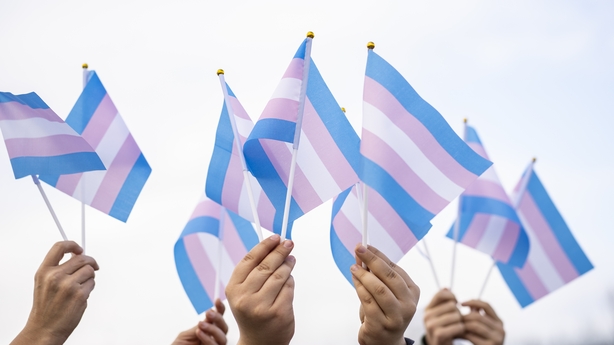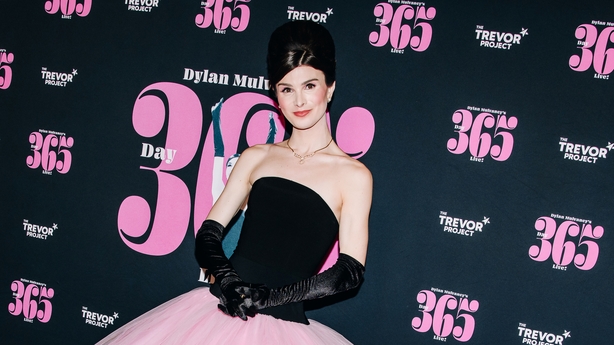The day was 6 April when The Marvelous Mrs Maisel actor Erin Darke became the subject of an online storm after trans-exclusionary pundits falsely insinuated that she was a closeted transgender woman.
It began, like these things often do, with a post by 'gender-critical' author Suzanne Seddon, who enlisted the help of a photo of Darke with her boyfriend, actor Daniel Radcliffe, with the caption:
"This is Daniel Radcliffes [sic] (Harry Potter) Girlfriend. Now what do you see?", followed by an emoji with a crumpled mouth and vexed expression.
The post suggested that Darke wasn’t presenting femininely enough; in the photo, and in real life, she is taller than her partner, with thick dark eyebrows and a structured jaw.
Replies to the original, now-deleted, tweet varied from the inflammatory to the bullishly absurd, with bolstered transphobic Twitter users suggesting that "it’s a bloke," while others claim she "definitely leaves the toilet seat up".
Not that it really matters, but Darke is a cisgender woman and is currently pregnant.

It’s a gentle introduction to the recent slate of transphobia-adjacent behaviour online attacking cisgender (denoting or relating to a person whose gender identity corresponds with the sex registered for them at birth; not transgender) women who the general public has not deemed feminine enough, thus suggesting that it was never a transgender issue in the first place, but a more critical form of misogyny.
The most recent, and frankly overt, resurgence began at the height of the second-wave feminist movement, namely at the 1973 West Coast Lesbian Conference, in Los Angeles.
The committee notoriously split over a scheduled performance by the folksinger Beth Elliott, who is what was then called a transsexual.
Robin Morgan, the keynote speaker, said: "I will not call a male "she"; 32 years of suffering in this androcentric society, and of surviving, have earned me the title "woman"; one walk down the street by a male transvestite, five minutes of his being hassled (which he may enjoy), and then he dares, he dares to think he understands our pain? No, in our mothers’ names and in our own, we must not call him sister."
Such views are, generally, rare among feminists today––several studies have found that people who identify as feminists tend to be more accepting of trans people than those who do not––but they still boast credence among some self-described radical feminists (TERFS or Transgender Exclusionary Radical Feminists, as you may have seen them abbreviated) who have found themselves in caustic battles with transgender people and those who support them.

Trans women, otherwise known as women, explain that they are so because their gender does not align with the sex they were assigned at birth, therefore a trans woman/girl is someone who was registered as male at birth but who lives as and whose identity is that of a woman/girl.
Radical feminists reject this notion, believing that if women think, act, and feel differently from men, it's because society forces them to, requiring them to be sexually attractive, nurturing, and polite.
Such views register feminism as less an identity and more a caste position, suggesting that male bodies, minds, and figures retain male privilege, even if they live as a woman. It’s the reason for the coining of the term transmisogyny, the intersection of transphobia and misogyny, as experienced by those deemed to fall outside of their extended gender binary.
The term was coined by Julia Serano in her 2007 book Whipping Girl, to describe a particular form of oppression experienced by transgender women. In an interview with the New York Times, Serano explores the roots of transmisogyny as a critique of feminine gender expressions which are "ridiculed in comparison to masculine interests and gender expression".
The idea that a woman may present as not the right kind of woman falls into the trap of eugenics, the empirical results of which are often contextualised within the bounds of androcentrism.
As such, it illustrates that transmisogyny is a manifestation of ‘femmephobia’, the cultural rejection of femininity and those associated with femininity.
The empirical results are then contextualised within sex-segregated spaces, in which stereotypical, potentially misogynistic tropes around the ‘ideal woman’ are drawn upon to delegitimise transgender women, or in Darke’s case, cisgender women, who do not meet, or conform to these gendered expectations––a dangerous practice being legitimised over time.
"It’s a tactic that’s been used again and again," TENI national community development officer, Lilith Ferreyra-Carroll, tells me over Zoom. "I guess you could call it a splash back, that cisgender women are receiving secondhand by way of transmisogyny.
"Transmisogyny is the idea that a trans woman will be treated as a woman, but when it’s discovered that they’re trans, they’ll be attacked, sometimes violently so, for being perceived as a failed man. And you know, more often than not, they’ll resort to body shaming in some way and it always leads to this notion that ‘we can always tell,’ leading to a weird subgenre of trans investigators which is where we are now."

To younger activists, it may seem obvious that anyone who objects to such changes is simply clinging to the privilege inherent in being cisgender, with others claiming that radical feminists’ beliefs hail from having been subject to serious trauma at the hands of some man, or multiple men.
Darke’s partner Radcliffe has been outspoken in his support of the trans community, partnering with US non-profit LGBTQ+ suicide prevention organisation The Trevor Project, for a video series called Sharing Space––perhaps serving to place him firmly on the radar of transphobic critics.
Six trans and nonbinary young people sat down with Daniel Radcliffe in a candid and heartfelt conversation about their journeys and what genuine allyship looks like.
— The Trevor Project (@TrevorProject) March 30, 2023
🎥The first episode of #SharingSpace premieres on YouTube tomorrow at 12 PM ET. ➡️ https://t.co/nlE3HxCkKn pic.twitter.com/nSjLLB5OZO
Darke’s association thus leaves her in the firing line, resulting in the ever-reliable act of picking apart her appearance, leading us to where we are now.
What this act most clearly reveals is that transphobia, and all of its insidious counterparts, was never about the protection of women, as some TERFS seem to claim, but about the eradication of difference, the obsessive enforcement of gender norms, and the pushing of oppressive standards of beauty that fewer and fewer woman could ever meet.
Not looking ‘feminine’ enough has been a rod used to beat successful women throughout history and is still employed today (Michelle Obama, Lady Gaga, Simone Biles, Caster Semenya) which quickly bleeds into homophobic rhetoric, where cis women are attacked for looking ‘manly’ or ‘like lesbians’.
Suffice to say, it’s about exclusion and ignorance, and upholding the patriarchal norms of a society that no longer serves us.
With that I leave you with this: if regressive policing continues, transgender people can never win––and neither can anyone else.
The views expressed here are those of the author and do not represent or reflect the views of RTÉ.


